A Brief Tour of Magic's Misprinted Cards
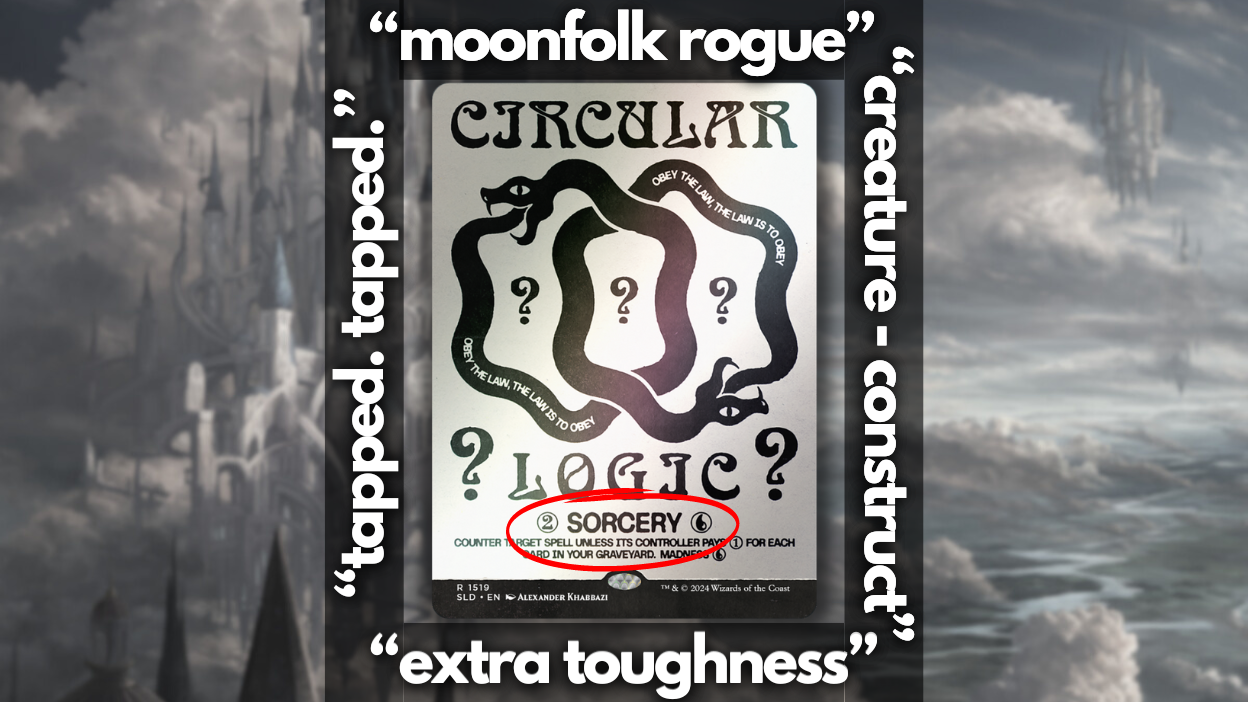
Circular Logic by Alexander Khabbazi
Reign of Errors
There are a lot of moving parts when it comes to designing a Magic: The Gathering card, and any mechanic will tell you, moving parts invite problems.
To date, there have been more than 30,000 unique Magic cards printed. Over the years, the vast majority of those cards are printed with the exact language as intended by designers. Sure, many older cards from the first few years of the game have been since reworded for clarity and to conform with modern interpretations of Magic rules, but that's hardly a surprise. Sometimes the text is updated for better understanding of the card's function, resulting in even more words. Such is the case of Illusionary Mask going from this to this.
Or sometimes they're updated for simplicity's sake, like in the case of a Revised Plateau shifting over to the templating of a Masters Edition IV Plateau.
But hold on a minute. Sure, those two Plateaus have different text boxes, that's all well and good. But there's also something else that changed between 1994 and 2011, when those two cards were printed (or in the case of the ME4 version...rendered?), and that's the artist attribution.
Mistakes Were Made
In the case of the aforementioned Plateau, there was a little snafu with the image file between Unlimited and Revised and some quick problem-solving prevented a printing delay but unintentionally caused a different issue entirely. I'll let Elaine Chase, former Brand Manager for Magic, explain:
When we were getting Revised ready to print, the image file of the original Plateau was corrupted. We contacted the artist, Drew Tucker, to see if we could use the original painting to make another scan. Unfortunately, Drew couldn't locate the piece. By this time, art for the Ice Age lands had already been commissioned but wouldn't be needed for a while, so one of those was snagged to be the new Plateau. The artist for the replacement piece is actually Cornelius Brudi, although it is misattributed to Drew on the actual card. The original Plateau art is on Alpha, Beta, and Unlimited versions of the card. The second painting only appears in Revised.
For context, here's Drew's actual art.
So if that mistake occurred way back in the mid-90s, surely things have been buttoned up since then to prevent further errors from making it to print. Right? Well, about that. There are actually many, many examples of cards getting from concept to packs while containing errors in the text, art or frame. These cards, for many years at least, became somewhat of an amusing oddity for collectors, but as printing errors continue, some have become less amused.
Let's take a look at the Top 10 Worst Magic Card Errors, and all the while we'll remind ourselves that everyone involved in these oopsies are human. Mistakes happen, even in Magic. Some might say especially in Magic. So be nice, and remember to always consult your Oracle text.
The Cost of Madness
Circular Logic
You've probably figured this out by now, but the entire reason this article was written now is because of the curious case of Circular Logic dominating the headlines of our hobby this week.
Actually, "curious" might not be the best word for it, but rather "blatant oversight."
For context, here's the original Circular Logic from Torment:
And here's the newly revealed Secret Lair version:
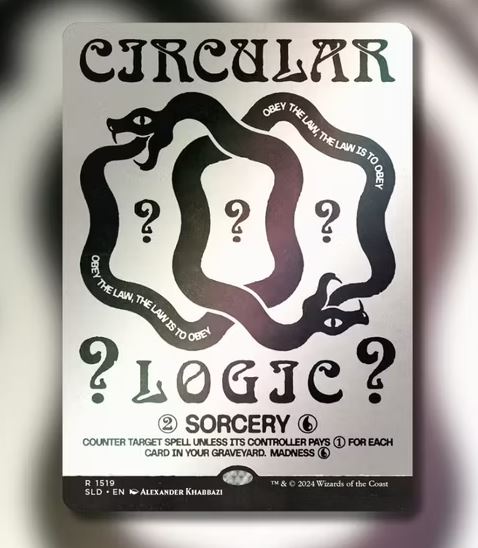
Let's pretend that we're back to being a 10-year-old in the pediatrician's waiting room, flipping through Highlights. Can you spot the difference?
If you circled "sorcery," you're correct. Good job. Don't forget your Tootsie Pop on the way out.
The official line from Wizards of the Coast PR regarding this error is as follows:
"The copy of the card Circular Logic found in the 'Deceptive Divination' drop was inadvertently printed as a sorcery, though we assure you, you can still cast it as an instant and the oracle text rules remain accurate. The error is found in both foil and non-foil versions. As a token of our embarrassment, please enjoy a $5 discount on this drop."
That error will be on every copy of the card in that particular Secret Lair drop, due largely to the fact that Secret Lairs are no longer print-to-order, so what's on the card is locked in at this point. As noted in the above quote, it's embarrassing, but with time Circular Logic will be welcomed into the annals of "Printed Goof-Em-Ups," an official term I didn't make up just now.
Saiba Trespassers
Here's the card as it appears today. You probably have a copy sitting in a box somewhere after a Kamigawa: Neon Dynasty preprelease, collecting dust since February of 2022.
Despite what the card's subtype would lead you to believe, Saiba Trespassers is not a Moonfolk Ninja. It's a Moonfolk Rogue. That's a pretty big difference if you're looking for the 99th card of your budget Anowon, the Ruin Thief or Yuriko, the Tiger's Shadow Commander decks. The official stance on Saiba Trespassers is as follows:
"The English printed version of Saiba Trespassers is misprinted with an incorrect creature type. The correct creature type according to Gatherer is 'Moonfolk Rogue.'"
Pretty cut-and-dry, but a glaring error nonetheless.
Llanowar Greenwidow
Sometimes, the error present on a printed card completely changes the card's impact on the game. Other times, it's just good for a chuckle and to reinforce the value of a skilled proofreader. On the topic of Llanowar Greenwidow from Dominaria United, it's the latter.
If you're having trouble spotting the problem, you're not crazy. I'm just messing with you. Here's the one with the issue:
Now do you see it?
Other than the art of the borderless version being weirdly washed out, the text of the card reads "Return Llanowar Greenwidow from your graveyard to the battlefield tapped, tapped." That's too many taps. In fact, it's double the taps.
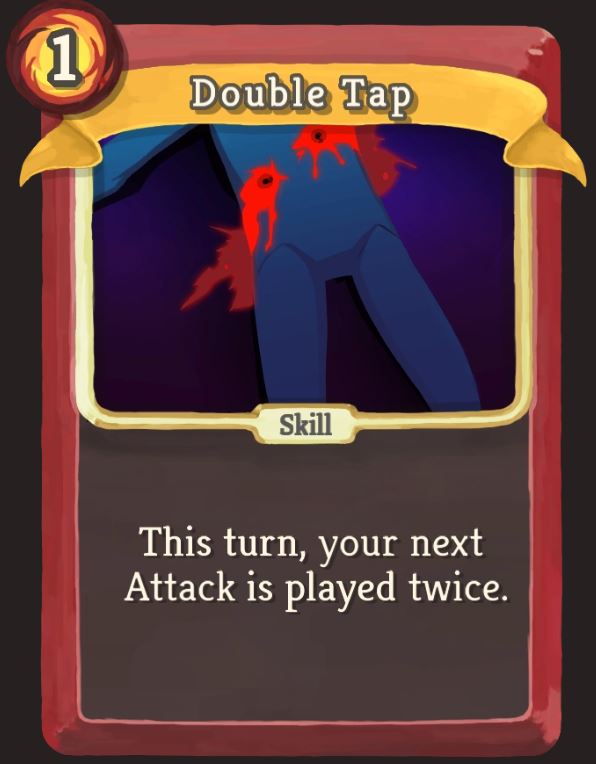
Like most errors of this variety, all you can really do is laugh about it, and that's exactly what the official Oracle text regarding the error does:
"Supertapping Greenwidow: The extended art version of Llanowar Greenwidow erroneously says 'tapped' twice. It just really needs a nap after its trip back from the graveyard, OK?"
Unfortunately, the supertapping Spider wasn't the only printing issue with Dominaria United. The card Heroic Charge attributes its art to Paul Scott Canavan, but longtime fans of the game probably knew immediately that the art on the card was unmistakably the prolific Zoltan Boros. Considering that Zoltan is credited with more than 360 Magic card illustrations over the course of almost two decades, I'm sure he didn't mind.
Fanatical Strength
Let's head back to the now of it all and talk about Murders at Karlov Manor. As many have realized by now, there's something weird with a handful of cards in the set, to the point where Facebook groups dedicated to misprints and printing errors are being required to do blanket PSAs to prevent a deluge of posts.
After the release of the set, players spotted unannounced variances, typically in the color of an object, in the art of Case of the Gorgon's Kiss, Clandestine Meddler, and Sudden Setback. These variant cards are not distinguishable by their collector number. They're all "clues" for an associated ARG (Augmented Reality Game) that I will not be going into here, but long story short, it's not a mistake. These are intentional differences.
When it comes to the magnifying glass showcase Fanatical Strength, though, there's something else going on, and it's the most dangerous game of them all: accidental oopsies.
You might not spy a problem with this card, but I can guarantee artist Joshua Cairos can. Evidently, the art on the card as printed on paper is actually a working version, and not the finished product. Wizards had this to say about the mistake: "An earlier version of the showcase artwork for Fanatical Strength in Murders at Karlov Manor inadvertently made it to print. This is being corrected digitally for Murders at Karlov Manor on MTG Arena and for tabletop on printed versions after the initial Murders at Karlov Manor release."
So if you opened any of the incorrect version of Fanatical Strength during the recent prerelease weekend, hold onto them. Just maybe don't ask Josh Cairos to sign them.
This also happened with a Secret Lair as recently as last year, this time affecting the art of Alayna Danner:

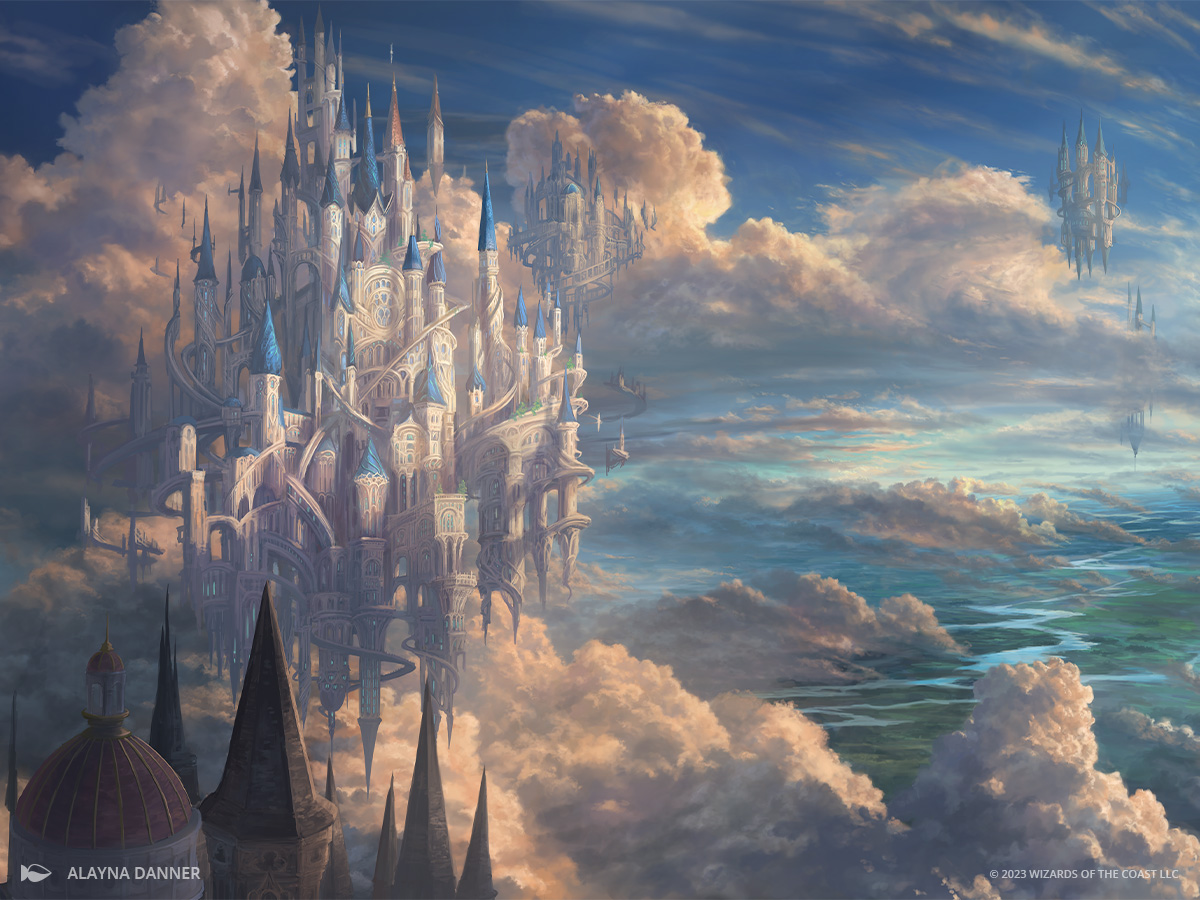
Here's the apology:
"While we usually try to keep the 'secret' elements of our Secret Lair products a surprise, this time, we can confirm that we will be printing the corrected version of the card and that it will be included as the "secret card" in a different, future Secret Lair product. We worked with Alayna Danner to come to this solution, and we are also giving her a number of copies of the corrected card version, in both foil and non-foil, to distribute at future conventions. We sincerely apologize for any inconvenience."
White Cards from Torment
Speaking of Torment, instead of an individual card being misprinted, a whole slice of the color pie was unjustly affected by a mistake.
Quick, grab your copy of Major Teroh to see what I mean. You don't have a copy of Major Teroh at arm's reach at all times? Fine, maybe this will help:
It's a bit harder to tell with the resolution of modern-day screens, but every white card from Torment was famously misprinted. Every one of the 21 white cards in the set have grainy, low-resolution, pixelated art. It's a good thing Torment was "the black set" and thus had a disproportionately small amount of nonblack cards. If you didn't know, Torment contained 40 black cards, while red and blue saw 28, and white and green only 21. The printing issue is probably best seen on cards like Transcendence or Aven Trooper (the former of the two is also incidentally a hilarious card and more people should play it).
Overall, this printing error is a fun example of how to spot a fake. In Torment's case, the grainy, poor image quality is the real version, and not the one printed on someone's Inkjet in their bedroom. Of course, why someone's creating a forgery of a white card from Torment, where the most expensive card is the uncommon Cleansing Meditation, is anyone's guess.
Walking Atlas
Much like Saiba Trespassers, the error on this one is specific to its type line. However, Worldwake's Walking Atlas's type isn't misrepresented, it's just not represented at all. Take a look:
Weirdly, this particular rambling McNally has never seen a reprint, so any copy out there that you might see is forever just "Creature -- Construct." As per official rulings, it is indeed an artifact, if you couldn't tell by the frame, the colorless casting cost or the general "animated map"-ness of it all. Here's the Oracle text, from 2010, shortly after Worldwake was sprung onto the world:
"The word 'artifact' was inadvertently omitted from Walking Atlas's type line. The card has received errata to correct this omission; it is an artifact creature."
Obviously, without knowledge of this errata, players could be pedantic with the whole reading the card explains the card ethos and try to claim in a Commander game that Walking Atlas won't trigger Dross Scorpion. That would be in bad faith. Don't be that person. In fact, similar issues arose more recently...
Corpse Knight
Back during the weekend of the Magic 2020 prereleases, event judges worldwide were racing to explain to players that yes, the card says it's a 2/3. But believe me, it's not.
It's a tough sell to try convincing someone that the brand-new card they just opened in their prerelease sealed pool is in fact wrong, especially if they weren't plugged into the ongoing spoilers leading up to the event weekend. Remember to be nice to your judges, they're beholden to Wizards misprints just like us all.
Here's a version of the actual card, found in most packs of M20:
And here's the version that some people found in packs, in the same set:
It's the same exact card, save for that little bump to toughness. But in a set where Shock was printed, that's a big deal. Of course, today the vast majority of copies out there in the wild have the correct stats, and counter to what you might think, the misprinted version is actually worth less than the right version and its various reprints. Shortly after the prerelease weekend was underway, Wizards did release a brief statement attributing the discrepancy to a "regional printing error."
The Case of Wyvern: Fallen Empires
So first, a little history lesson. Way back in 1995, a trading card game called Wyvern was debuting, published by a company called Carti Mundi.
The initial set, called Premiere Limited, hit shelves in January of '95, followed by a "Limited Edition" expansion in March of the same year. There were a few other releases over the next couple years, but those aren't relevant to our topic today. And if you're curious, Wyvern is a game where dragons and wyverns battle over treasure.
When the "Limited Edition" print run of Wyvern was in full swing, there was a rival trading card game readying its own expansion, called Fallen Empires. It just so happened that both sets were being printed in the same facility.
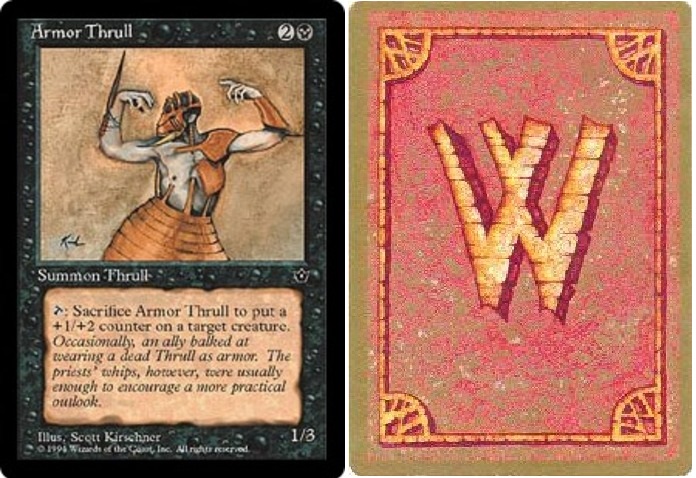
Blamed on a "printing error," a finite number of cards bearing Wyvern backs and Magic, specifically Fallen Empires, faces could be found in Starter Decks for the latter release. While these misprints were found in Magic product releases, who's to say whether they're Wyvern cards or Magic cards? Which part makes the card?
If you wanted to own your own piece of Magic (or Wyvern) weirdness, be ready to pony up. What listings you can find will ask for around $500, which is a lot for a card from Fallen Empires, a set where the most expensive card is six dollars.
Cephalid Looter
Another famous type line snafu, and one close to our own Naomi Krause's heart.
According to lore, an "unknown number" of Cephalid Looters from Odyssey picked up an extra job title sometime between design and printing. For reference, here's the "correct" version:
And here's the "incorrect" version:
As you can see, there's an extra "Wizard" creature type present on some copies. And only some. No telling how many. So go check your Odyssey bulk and see if you've got one of the weird ones.
In fact, after the Grand Creature Type Update of 2007, Cephalid Looter still wasn't allowed to practice wizardry. Following that shakeup, the card is now actually identified as a "Cephalid Rogue."
At least both versions have that amazing flavor text intact.
Hurricane
When it comes to misprints from the beginnings of Magic, we have to give the majority of them a pass. Times were different, things were new, designing a game is hard, and attention to detail is a skill that not everyone possesses.
We could go on and on about the two slashes of Birds of Paradise, the many, many incorrect artist attributions, the artist attributions that misspell the artist's name, the "U" instead of the blue mana symbol on Phantasmal Forces or the "BBB" instead of three black mana symbols on Demonic Hordes, the incorrect mana cost on Orcish Oriflamme, the fact that the casting cost on Cyclopean Tomb is straight up missing entirely, or Unsummon's "creature are CARD ed" text.
But we won't. Instead, we'll talk about Summer Magic.
In 1994, Revised Edition was shipping out, and soon after, designers began experiencing a deluge of calls describing a multitude of errors. Serendib Efreet had the wrong art and border, the colors on the cards were washed out, and Unholy Strength had that spooky pentagram in the background over which parents were clutching pearls. To be fair, this was right in the middle of the Satanic Panic, so Wizards was just asking for trouble with that one.
To rectify the situation, designers came up with Summer Magic, a "fixed" version of Revised that was created a few months following Revised's goofs, earning that nickname because, as you might have guessed, it was released in the summer of '94.
However, the "fixed" version did more harm than good. They overcorrected the saturation issue and now many cards were too dark. Serendib's art was now correct but they forgot to update the artist attribution. They got rid of the 'gram on Unholy Strength and the one on the forehead of Demonic Tutor's demonic tutor, but they must have missed the one on his pec.
Because of these issues, Summer Magic was marked for the incinerator. That's no exaggeration: it was literally ordered to be destroyed in its entirety. Lucky for us (and unlucky for Wizards), an estimated 40 booster boxes of Summer Magic leaked out and were found for purchase in a handful of locations.
So Summer Magic is incredibly rare, and the most sought-after misprint contained within is Hurricane.
Much like its efreet cousin from Revised, Hurricane has the wrong border, appearing like a blue card instead of the intended green. Unlike Serendib Efreet, though, the Summer Magic Hurricane is incredibly rare.
So if you want one, I hope you have a lot of discretionary income, or at least a lack of financial responsibility. Copies have sold for tens of thousands of dollars, and only around 50 are known to exist. For misprint collectors, a Blue Hurricane is one of the Holy Grails of the hobby, and for good reason.
A Frazzled Editor
That's 10 (or so) of the most egregious misprints in Magic's history, but there are many, many more, to the point where everyone's got a favorite they'll point to when the topic comes up.
So what's yours?